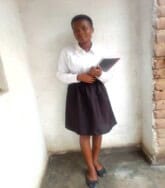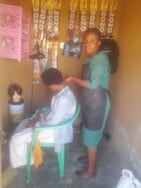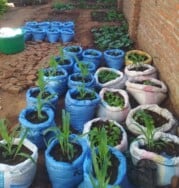A Holistic, Integrated Approach to Youth Development
August 6th, 2024 | Blogs
Young people in many countries face complex inter-related challenges that require a multi-faceted response. Integrated development provides just that. It can help solve entrenched problems such as lack of access to quality education, health care, and employment opportunities by calling for programs to work across sectors, build the agency of individuals, and strengthen community support networks. It’s a powerful framework for facilitating coordinated responses to pressing social issues.
In Malawi, integrated development is helping three young women—Ethel, Talandira, and Yankho—lead healthier lives. All three faced substantial challenges, including incomplete schooling, scarce employment opportunities, and health risks arising from a lack of access to health education. Through the Ana Patsogolo Activity (APA), led by World Education and funded by the U.S. Agency for International Development (USAID), the three young women accessed a range of education, employment, and health services to overcome obstacles and build better futures. APA supports Malawi’s commitments to achieving zero new HIV infections, zero AIDS-related deaths, and zero discrimination, especially as they relate to adolescent girls and young women.
The steps that follow describe how integrated development helped Ethel, Talandira, and Yankho become lifelong learners with a strong foundation of knowledge and skills for navigating future challenges.
Programs must first assess the needs of youth and understand the barriers to fulfilling those needs. Social workers and community case workers play a crucial role in this process, using case management to conduct thorough assessments and build rapport with the individual.
Ethel was living alone and supporting herself at a young age. Although she finished secondary school and found employment, she was invited to join DREAMS by her friend, a program facilitator and mentor, to learn important life skills, like HIV-prevention methods.

As a PEPFAR model, DREAMS seeks to prevent HIV among adolescent girls and young women by addressing vulnerabilities related to HIV risk. APA uses a screening tool to identify eligible candidates for the DREAMS program, collaborating with health clinics and local partners to find those who need support and connect them to services.
APA’s early warning system identified Talandira as a girl at risk of leaving school and used a case management approach to ensure school retention.
I was one of the fortunate ones to be enrolled and participate in DREAMS clubs. This became my turning point as APA provided me with scholastic materials but also alleviated the burden of school fees,” she said.
After identifying needs and barriers, programs should create a comprehensive plan to address the individual’s needs. The plan might involve helping the individual re-enroll in school or begin a vocational training program, access health care services, or apply for internship and mentorship opportunities. Partnerships with civil society organizations, schools, health clinics, and local businesses are instrumental in implementing these interventions.

After building life skills through DREAMS, Ethel enrolled in the Siyahka program. Siyakha is a model developed by World Education to strengthen young women’s economic resilience while linking them to health and social services. When Ethel was accepted into Siyakha, she left her job as a security guard to pursue a career in cosmetology. She trained at DAPP Vocational School and started a salon that allows her to support herself while doing a job she enjoys.
Yankho, a first-born daughter who needed to help support her family, also had the opportunity to build skills at DAPP Vocational School. After she learned farming practices, Siyahka connected her with an internship opportunity at an agricultural training center to gain hands-on experience. She used her new skills to start growing and selling vegetables on her own piece of land, earning income to support herself and her family.
Integrated development includes strengthening support networks to ensure that young people who have improved their access to education, health care, and economic opportunity can maintain those gains and make additional progress. Community leaders, peer groups, and caregivers play important roles in this process. Local institutions, such as village savings and loan associations, can keep youth focused on economic self-sufficiency.
To increase Talandira’s chances of finishing school after re-enrolling, a DREAMS program facilitator connected her with a local organization, Hope for the Heart, which gave her essential school materials and a uniform.

Yankho joined a village savings and loan association, where she learned how to manage the money she earned from farming to maintain her financial security. “I no longer feel helpless or dependent; instead I am empowered and self-reliant. I hope that in the near future my business will grow and I will be able to hire laborers. But for now, I am very satisfied that I am able to support my family in ways I never could before,” she said.
Programs should establish ongoing follow-up and evaluation mechanisms to monitor progress and adjust interventions as needed. They can also advocate for policy changes, scale up successful interventions, and build the capacity of stakeholders involved in youth development.
In Malawi, World Education is shifting ownership of APA interventions to the national government while helping government leaders and staff strengthen their capacity to sustain the interventions. By creating a cost-effective and easy-to-implement package of youth development, health care, and child protection services, we’re working to ensure that young women like Ethel, Talandira, and Yankho can continue to pursue their goals while remaining healthy and safe.
Embracing integrated development and working collaboratively across sectors helps programs empower young individuals to overcome obstacles, fulfill their potential, and contribute positively to their communities. Through personalized interventions, strengthened support networks, and a commitment to holistic development, we can create pathways to brighter futures for all youth.
World Education fosters enduring partnerships across regions and sectors to advance education outcomes for all. We offer education systems strengthening, program design and implementation, applied research and evaluation, capacity development, and policy development services.